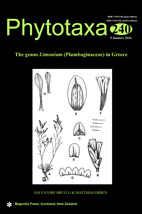Abstract
The genus Limonium (Plumbaginaceae) in Greece is taxonomically revised based on morphological and morphometric studies. More than 3000 herbarium specimens were used, sourced mainly from field excursions carried out over the last thirty years by S. Brullo, as well as from numerous collections held in the herbaria of European museums and private collections. A significant aspect of this revision concerned the nomenclatural resolution of critical taxa from Greece. Scanty and unclear original descriptions have led to numerous mis-identifications in the past. Nomenclatural studies have resolved the taxonomic uncertainties and the necessary associated lecto-typifications are published here, notably for those species formerly known as Statice graeca, S. rorida, S. aucheri, S. ocymifolia, S. palmaris, S. prolifera, S. hyssopifolia and S. sieberi. Using the phylogenetic species concept 85 morphologically well-defined species of Limonium are recognized in Greece. The species are predominantly distributed in coastal habitats, being well-adapted to sea spray and even to conditions of marked edaphic salinity. Morphology, nomenclature, distribution and ecology have been analyzed for all species. Taxonomic notes, new illustrations and a list of the examined specimens are also provided. Two new combinations are made (L. proliferum and L. stenotatum) and thirty nine species are described as new to science (L. aegaeum, L. amopicum, L. archaeothirae, L. astypaleanum, L. athinense, L. atticum, L. chersonesum, L. compactum, L. contractum, L. crateriforme, L. dolihiense, L. fragile, L. grabusae, L. helenae, L. heraionense, L. ikaricum, L. isidorum, L. kirikosicum, L. meandrinum, L. microcycladicum, L. minoicum, L. monolithicum, L. oligotrichum, L. pagasaeum, L. parosicum, L. pusillum, L. reticaule, L. samium, L. sartorianum, L. schinousae, L. sirinicum, L. sougiae, L. spreitzenhoferi, L. taenari, L. thirae, L. vanandense, L. vravronense, L. xerocamposicum and L. xiliense). The chromosome complement is reported for 51 species. New chromosome counts are given for 16 species and those of 14 species are confirmed. Finally, an analytical key for the easy identification of the treated species is provided. 24 names are lectotypified in the present paper: Limonium sitiacum (specimen at G), L. runermakii (M), L. hierapetrae (W), L. graecum var. stenotatum (W), Statice echioides (illustration by Magnol), S. aristata (illustration by Magnol), S. serotina (illustration by Reichenbach), S. virgata var. tenia (W), S. rorida, S. palmaris, S. bellidifolia (illustrations by Sibthorph & Smith) S. hyssopifolia (M), S. tournefortii (P), S. carpatha (G), S. pigadiensis (M), S. graeca (P), S. prolifera (M), S. ocymifolia (P), S. aucheri (P), S. corinthiaca (G), S. frederici (P), S. doelferi (M). Isolectotypes were found for: Limonium sitiacum (K, W), L. runemarkii (B, G, W), L. hierapetrae (G, M), L. graecum var. stenotatum (BM, M), Statice virgata var. tenia (M, W), S. carpatha (B, M, W, WU), S. pigadiensis (BM, G, W), S. graeca (BM, C, LD, M, P, OXF), S. prolifera (P), S. ocymifolia (FI, G), S. aucheri (BM, FI, G, P), S. corinthiaca (BM, W, WU), S. frederici (G, FI, K), S. doerfleri (B, FI, G, P, PR, W, WU, Herb. Greuter). An epitype (B) was proposed for S. palmaris.

